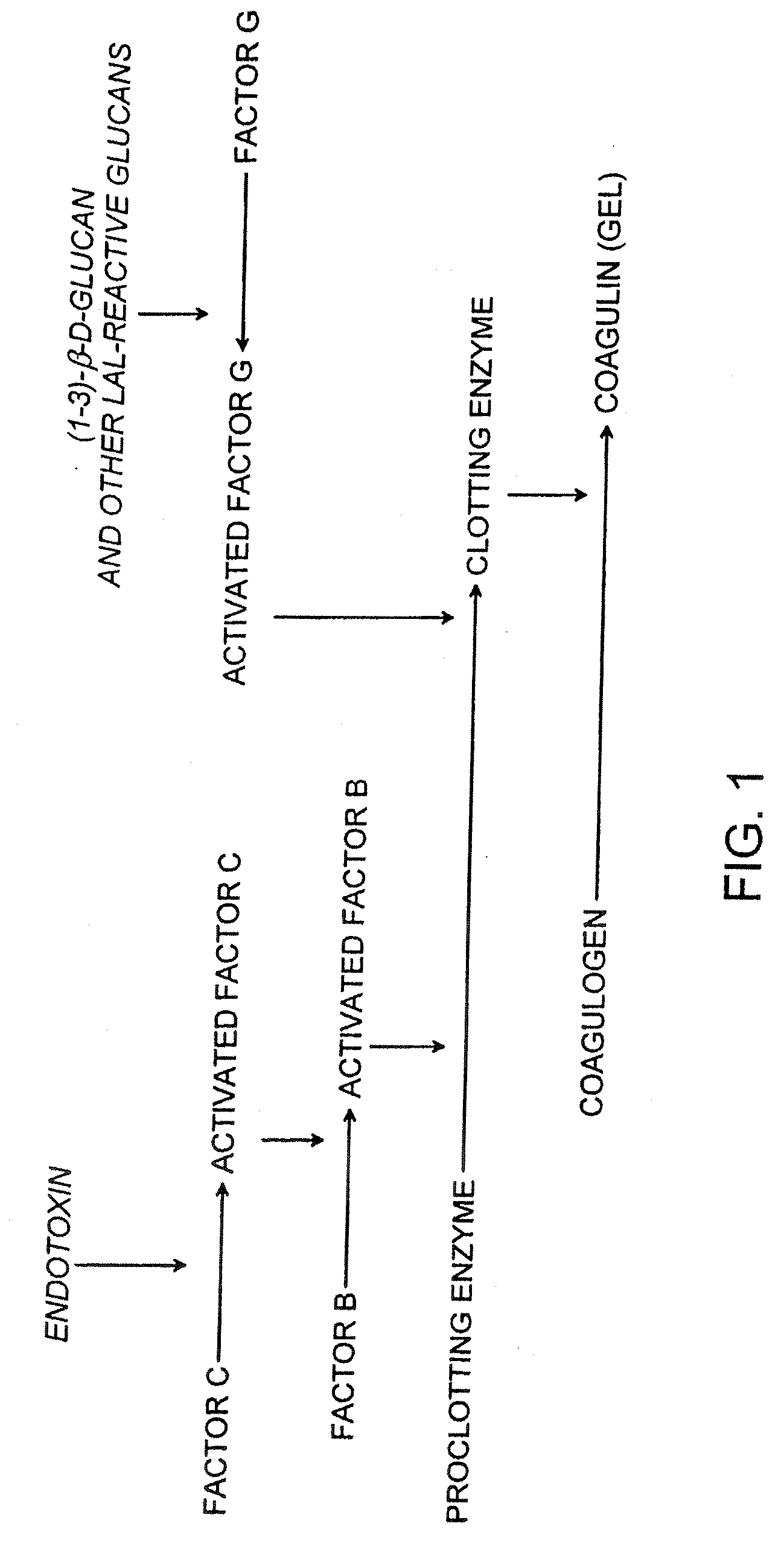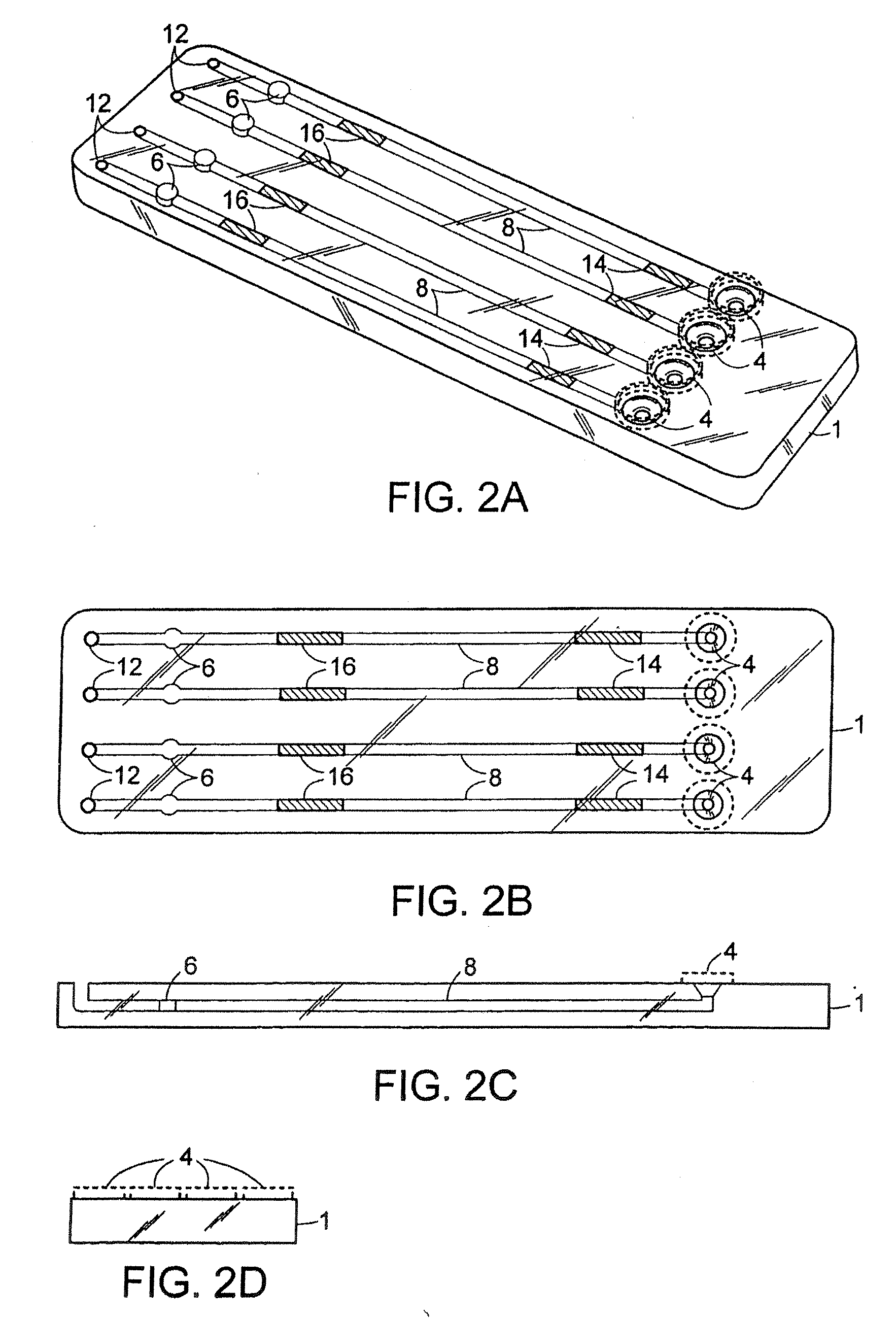Methods and Compositions for the Detection of Microbial Contaminants
- Summary
- Abstract
- Description
- Claims
- Application Information
AI Technical Summary
Benefits of technology
Problems solved by technology
Method used
Image
Examples
example 1
Preparation of the Chromogenic Assay Cartridge
[0119] An exemplary cartridge shown in FIG. 2 was prepared as follows. Referring to FIG. 5A, the LAL and chromogenic substrates were applied to regions 14′ and 16′, respectively, of conduit 8′ of the bottom half 2 of the cartridge 1 using a Hamilton Microlab 540B Dispenser (Hamilton Company, Reno, Nev.). Briefly, 4-5.0 μL of 10 mg / mL Endosafe LAL (Charles River Endosafe, Charleston, S.C.) containing 1% mannitol (Osmitrol, Baxter, Deerfield, Ill.) and 0.1% dextran (MW 10-100K, Sigma-Aldrich, St. Louis, Mo.), was applied to regions 14′. 4-5.0 μL of (1.3 mg / mL) chromogenic substrate Ile-Glu-Ala-Arg-pNA Chromogenix S-2423 (Instrumentation Laboratories, Milan, Italy) containing 1% polyvinyl alcohol (PVA) (MW 7K-30K, Sigma-Aldrich, St. Louis, Mo.), was applied to regions 16′. The bottom half 2 of the cartridge 1 was dried under a controlled temperature of 25° C.+ / −2° C. and a humidity of 5%+ / −5% in a Lunaire Environmental Steady State & Stabi...
example 2
Cartridge-Based Assays
[0123] This example demonstrates that a cartridge of the invention can be used to measure the amount of a microbial contaminant by an endpoint chromogenic assay, kinetic chromogenic assay and a multi-step chromogenic assay.
[0124]FIG. 8 shows how the cartridge of the invention may be used with a portable hand-held optical detector. FIG. 8A shows the cartridge in the process of being inserted into the optical detector. FIG. 8B shows the cartridge inserted fully into the optical detector, however, the fluid inlet ports of the cartridge are still accessible to the user. This configuration permits the user to apply one or more samples of interest to the exposed fluid inlet ports even though the optical cells of the cartridge are located in place within the optical detector.
(I) Endpoint Chromogenic Assay in a Cartridge
[0125] A cartridge was prepared essentially as described in Example 1, with the exception that no spikes were added to the conduits. Samples of en...
example 3
Microplate-Based Assays
[0129] This example demonstrates that a multi-well microtiter plate can be fabricated so that the amount of a microbial contaminant (bacterial endotoxin in this example) can be measured by an endpoint chromogenic assay, a single-step kinetic assay and a multi-step assay.
(I) Single-Step Kinetic Assay on a Microplate
[0130] A single-step kinetic chromogenic assay was performed as follows. Briefly, 50 μL of a control microbial contaminant of interest (e.g., 5 EU / mL, 0.5 EU / mL, or 0.05 EU / mL of Endosafe Control Standard Endotoxin (CSE), Charles River Endosafe, Charleston, S.C.), was added to one or more wells of a 96 well plate. 50 μL of 5 mg / mL Endosafe LAL (Charles River Endosafe, Charleston, S.C.) and 5 μL of 1.3 mg / mL Chromogenix S-2423 chromogenic substrate (Instrumentation Laboratories, Milan, Italy) were added to each well and incubated at 37° C. for 32 minutes. The optical density of the mixture in each well was monitored by a spectrophotometer, such as...
PUM
| Property | Measurement | Unit |
|---|---|---|
| Volume | aaaaa | aaaaa |
| Volume | aaaaa | aaaaa |
| Volume | aaaaa | aaaaa |
Abstract
Description
Claims
Application Information
 Login to View More
Login to View More - R&D
- Intellectual Property
- Life Sciences
- Materials
- Tech Scout
- Unparalleled Data Quality
- Higher Quality Content
- 60% Fewer Hallucinations
Browse by: Latest US Patents, China's latest patents, Technical Efficacy Thesaurus, Application Domain, Technology Topic, Popular Technical Reports.
© 2025 PatSnap. All rights reserved.Legal|Privacy policy|Modern Slavery Act Transparency Statement|Sitemap|About US| Contact US: help@patsnap.com



